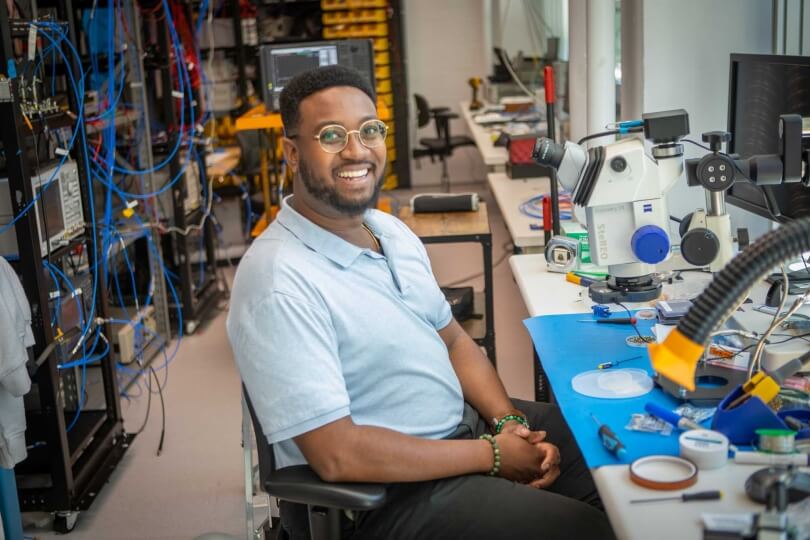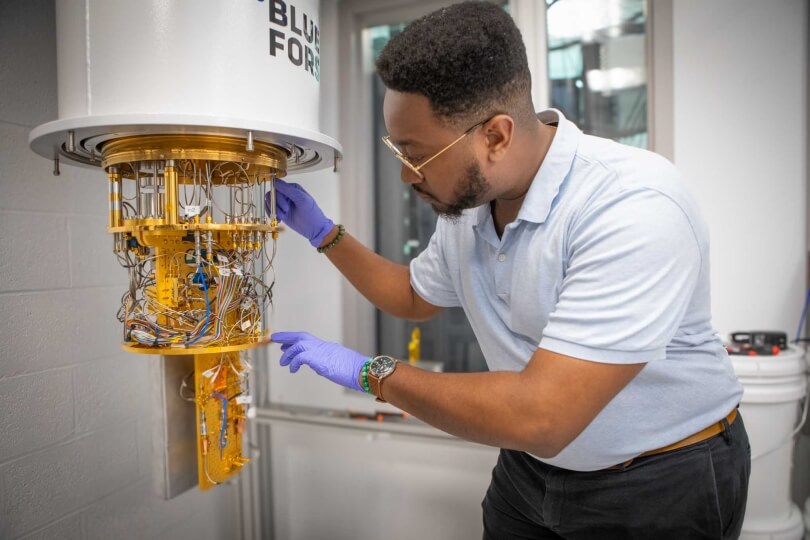Gregory Cunningham, Ph.D. candidate in applied physics (Eliza Grinnell/SEAS)
Gregory Cunningham knew he’d need a Ph.D. to really make an impact in STEM, but wasn’t sure of the specific discipline. A Michigan native, he’d majored in engineering physics and electrical engineering as an undergraduate at the University of Michigan, but the physics Ph.D. programs he looked at seemed designed for students with more experience in theory. Cunningham’s coursework and summer internships included electrical and mechanical engineering, and he wanted a program that would combine his loves of physics, math and engineering.
As he was pondering his future, Cunningham also took a class on quantum mechanics, which introduced him to quantum computing. That opened his eyes to the cutting edge of computation, and he knew what he wanted to study. Looking for a program that would allow him to be part of the quantum revolution, he picked the applied physics program at the Harvard John A. Paulson School of Engineering and Applied Sciences (SEAS).
“It seemed like it would allow me to go in whatever direction I wanted to, and that was something that drew me in. I already had a lot of exposure to classical electronics, and, at the beginning, the degree was a lot more theoretical, so that tapped into my love of physics.
As I started progressing through the Ph.D., the work that I was doing became much more simulation-oriented. But seeing what my other labmates were doing, getting to work on their experiments with them, has been a major blessing.”
Cunningham’s academic advisor at SEAS is Evelyn Hu, Tarr-Coyne Professor of Applied Physics and of Electrical Engineering, and his research is based out of the Quantum Coherent Electronics Group at MIT led by Kevin O’Brien, Associate Professor of Electrical Engineering and Computer Science.
Like traditional computers, which process computation using bits of information, quantum computers use quantum bits, or qubits. And like traditional computers, the more qubits you have in your processor, the faster and more powerful that quantum computer becomes. But housing more superconducting qubits means optimizing their housing units known as dilution refrigerators, which keep the qubits at thousandths of degrees above absolute zero. And the greater the number of qubits, the more cables you need to control them, all of which give off heat in the dilution refrigerator.
“There’s a large gap between the control electronics we have here at room temperature and the temperature that the qubits need to be at,” Cunningham said. “As we scale up to thousands of qubits, if a hundred of them have an error, by the time we get information from them, it may be too late to correct and we can’t trust the computation.”
Gregory Cunningham's research at the Quantum Coherent Electronics Group at MIT focuses on decreasing the temperature gap between quantum computing dilution refrigerators and their control electronics (Eliza Grinnell/SEAS)
Cunningham’s research has focused on using nonlinear circuit elements to bring the control electronics from room temperature closer to the low temperature environment of the qubit, making it easier to address latency and heat loads while scaling up computational capabilities.
Alongside his research, Cunningham has also been a teaching fellow at SEAS for “AP216: Quantum and Classical Electromagnetic Interaction with Matter.” Teaching and mentorship have always been important to him, whether that’s as a SEAS TF, private tutor, mentorship chair of the Harvard Graduate Society of Underrepresented Students in STEM (GSUSS) or co-founder of the Harvard-MIT chapter of the National Society of Black Physicists.
“We saw that there aren’t a lot of spaces for minority students specifically in STEM, especially in disciplines like physics and chemistry,” he said. “Celebrating different backgrounds, having a space where you don’t have to be on edge, where you can just have a space to relax, eat some food, and talk about everything from the hardest problem in your lab or the hardest level in a video game you’re playing, is what I wanted for that organization.”
Cunningham plans to take a break from academia after graduating. Also interested in renewable energy and nuclear fusion, he hopes to explore those industries, either through a start-up or with a venture capital firm. But inspired by his time at SEAS and MIT, Cunningham hopes to return to a university 4-5 years from now, where he can continue the teaching and research that he loves.
“The resources at Harvard that were afforded to me were massive, and I’m very grateful for them,” he said. “The way I operate as a student, having a certain level of autonomy is helpful, and this pathway afforded me the autonomy to be able to go between both campuses, talk to whoever I needed to for my research. The main advice I would give to people doing this is to really know what’s most important to you, so you can find an advisor that aligns with that and can take you to the next level.”
Press Contact
Matt Goisman | mgoisman@g.harvard.edu

